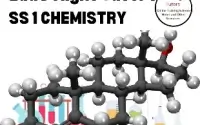Understanding the Digestive, Respiratory, and Nervous Systems of Farm Animals Animal Husbandry SS 1 First Term Lesson Notes Week 9
Animal Husbandry SS 1 First Term Lesson Notes – Week 9
Subject:
Animal Husbandry
Class:
SS 1
Term:
First Term
Week:
9
Age:
14 – 16 years
Topic:
Parts, Organs, and Functions of Farm Animals IV
Sub-Topic:
- Digestive System
- Respiratory System
- Nervous System
- Reproductive System (Male and Female)
Duration:
40 minutes
Behavioral Objectives:
By the end of the lesson, students should be able to:
- Identify the main parts and organs of the digestive, respiratory, and nervous systems in farm animals.
- Explain the functions of these systems.
- Discuss the significance of these systems in maintaining the health and productivity of farm animals.
Keywords:
- Digestive system
- Respiratory system
- Nervous system
- Reproductive system
- Anatomy
Set Induction:
The teacher initiates a discussion by asking students about their favorite foods and how animals digest their meals, leading into the importance of the digestive system in farm animals.
Entry Behavior:
Students have learned about the skeletal and reproductive systems in farm animals.
Learning Resources and Materials:
- Diagrams of the digestive, respiratory, and nervous systems
- Models of animal organs
- Videos showing the functions of these systems
Building Background/Connection to Prior Knowledge:
This lesson builds on previous knowledge about farm animal anatomy, focusing on the critical systems necessary for survival and health.
Embedded Core Skills:
- Critical thinking
- Observation
- Collaboration
- Communication
Learning Materials:
- Notebooks
- Textbooks
- Whiteboard and markers
Reference Books:
- Lagos State Scheme of Work
- Agricultural Science for Senior Secondary Schools by O.A. Iwena
Instructional Materials:
- Anatomical charts of the digestive, respiratory, and nervous systems
- Interactive models for demonstration
Content:
Parts, Organs, and Functions of Farm Animals IV
1. Digestive System
The digestive system is responsible for breaking down food into nutrients that can be absorbed. It includes:
- Main Parts:
- Mouth
- Esophagus
- Stomach
- Intestines (small and large)
- Anus
Functions of the Digestive System:
- Digests Food: The digestive system breaks down food into metabolic nutrients.
- Absorbs Nutrients: It absorbs essential nutrients for energy and growth.
2. Respiratory System
The respiratory system is vital for gas exchange in farm animals. It includes:
- Main Parts:
- Nose
- Trachea
- Lungs
- Diaphragm
Functions of the Respiratory System:
- Provides Oxygen: Delivers oxygen for metabolic processes.
- Removes Carbon Dioxide: Eliminates waste gases produced during metabolism.
3. Nervous System
The nervous system controls body functions and responses to stimuli. It includes:
- Main Parts:
- Brain
- Spinal cord
- Nerves
Functions of the Nervous System:
- Enhances Stimuli: Processes sensory information and coordinates responses.
- Regulates Body Functions: Controls involuntary functions such as heart rate and digestion.
4. Reproductive System
The reproductive system is essential for producing offspring. It consists of:
- Male Reproductive System:
- Testes
- Penis
- Accessory glands
- Female Reproductive System:
- Ovaries
- Uterus
- Vagina
Functions of the Reproductive System:
- Produces Offspring: Responsible for the generation of new individuals.
- Hormonal Regulation: Produces hormones that regulate reproductive cycles.
15 Fill-in-the-Blank Questions (Multiple Choice):
- The ______ system is responsible for breaking down food.
a) Respiratory
b) Digestive
c) Nervous
Answer: b - Which organ is part of the respiratory system?
a) Stomach
b) Lungs
c) Testes
Answer: b - The main function of the nervous system is to ______.
a) Digest food
b) Process sensory information
c) Absorb nutrients
Answer: b - The ______ is responsible for gas exchange in animals.
a) Stomach
b) Lungs
c) Intestines
Answer: b - The primary role of the digestive system is to ______.
a) Produce hormones
b) Support the body
c) Break down food
Answer: c - The ______ system provides oxygen for metabolic processes.
a) Nervous
b) Digestive
c) Respiratory
Answer: c - The ______ system helps in the production of offspring.
a) Nervous
b) Digestive
c) Reproductive
Answer: c - The main organs of the digestive system include the mouth and ______.
a) Nose
b) Lungs
c) Intestines
Answer: c - The ______ regulates involuntary body functions.
a) Digestive system
b) Nervous system
c) Reproductive system
Answer: b - The ______ is where gas exchange occurs in the respiratory system.
a) Trachea
b) Stomach
c) Lungs
Answer: c - The testes are part of the ______ reproductive system.
a) Male
b) Female
c) Digestive
Answer: a - Nutrient absorption occurs primarily in the ______.
a) Stomach
b) Small intestine
c) Lungs
Answer: b - The diaphragm is a muscle that aids in ______.
a) Digestion
b) Breathing
c) Circulation
Answer: b - Hormones produced by the reproductive system regulate ______.
a) Digestion
b) Reproduction
c) Circulation
Answer: b - The ______ system helps enhance responses to environmental stimuli.
a) Digestive
b) Nervous
c) Respiratory
Answer: b
15 Frequently Asked Questions (FAQs) with Answers:
- What are the main parts of the digestive system in farm animals?
The main parts include the mouth, esophagus, stomach, intestines, and anus. - How does the respiratory system work?
It allows for gas exchange, delivering oxygen to the body and removing carbon dioxide. - What is the function of the nervous system?
It processes sensory information and coordinates responses to stimuli. - What organs are involved in the reproductive system?
The male system includes the testes and penis; the female system includes the ovaries and uterus. - How does the digestive system contribute to animal health?
It breaks down food and absorbs nutrients essential for energy and growth. - Why is oxygen important for animals?
Oxygen is needed for metabolic processes that produce energy. - What role does the nervous system play in maintaining homeostasis?
It regulates involuntary functions such as heart rate and digestion. - How does the digestive system ensure efficient nutrient absorption?
It breaks food down into smaller molecules that can be easily absorbed in the intestines. - What are some common disorders of the respiratory system in farm animals?
Common disorders include pneumonia, asthma, and bronchitis. - How does the reproductive system ensure genetic diversity?
Through sexual reproduction, it combines genes from both parents to create diverse offspring.
10 Evaluation Questions:
- List the main organs of the digestive system in farm animals.
- Describe the function of the lungs in the respiratory system.
- Explain how the nervous system enhances responses to stimuli.
- Compare the roles of the male and female reproductive systems.
- Discuss how the digestive system supports overall animal health.
- What is the significance of oxygen for farm animals?
- How does the respiratory system remove waste gases?
- Describe the relationship between the nervous system and body functions.
- Explain the importance of the reproductive system in livestock management.
- What are the potential consequences of malfunctioning digestive and respiratory systems?
Conclusion:
In this lesson, students learned about the parts and functions of the digestive, respiratory, and nervous systems in farm animals. Understanding these systems is essential for promoting animal health and productivity.
Related
Related posts:
- First Term Review Assessment Test Questions Animal Husbandry SS 1 First Term Lesson Notes Week 11
- First Mid Term Test Animal Husbandry SS 1 First Term Lesson Notes
- Livestock Reproduction: Key Terms and Definitions Animal Husbandry SS 1 First Term Lesson Notes Week 10
- Exploring the Nutritional Classification of Non-Ruminant Farm Animals Animal Husbandry SS 1 First Term Lesson Notes Week 3
- Nutritional Classification of Farm Animals Animal Husbandry SS 1 First Term Lesson Notes Week 2
Related Posts

Understanding HIV/AIDS: Causes, Effects, and Prevention in Civic Education for SSS 1 Students Civic Education SS 1 First Term Lesson Notes Week 5

Christian Religious Studies SS 1 First Term Lesson Notes

First Term Examination Questions Chemistry SS 1 First Term Lesson Notes Week 12
About The Author
Edu Delight Tutors
Am a dedicated educator with a passion for learning and a keen interest in technology. I believe that technology can revolutionize education and am committed to creating an online hub of knowledge, inspiration, and growth for both educators and students. Welcome to Edu Delight Tutors, where learning knows no boundaries.